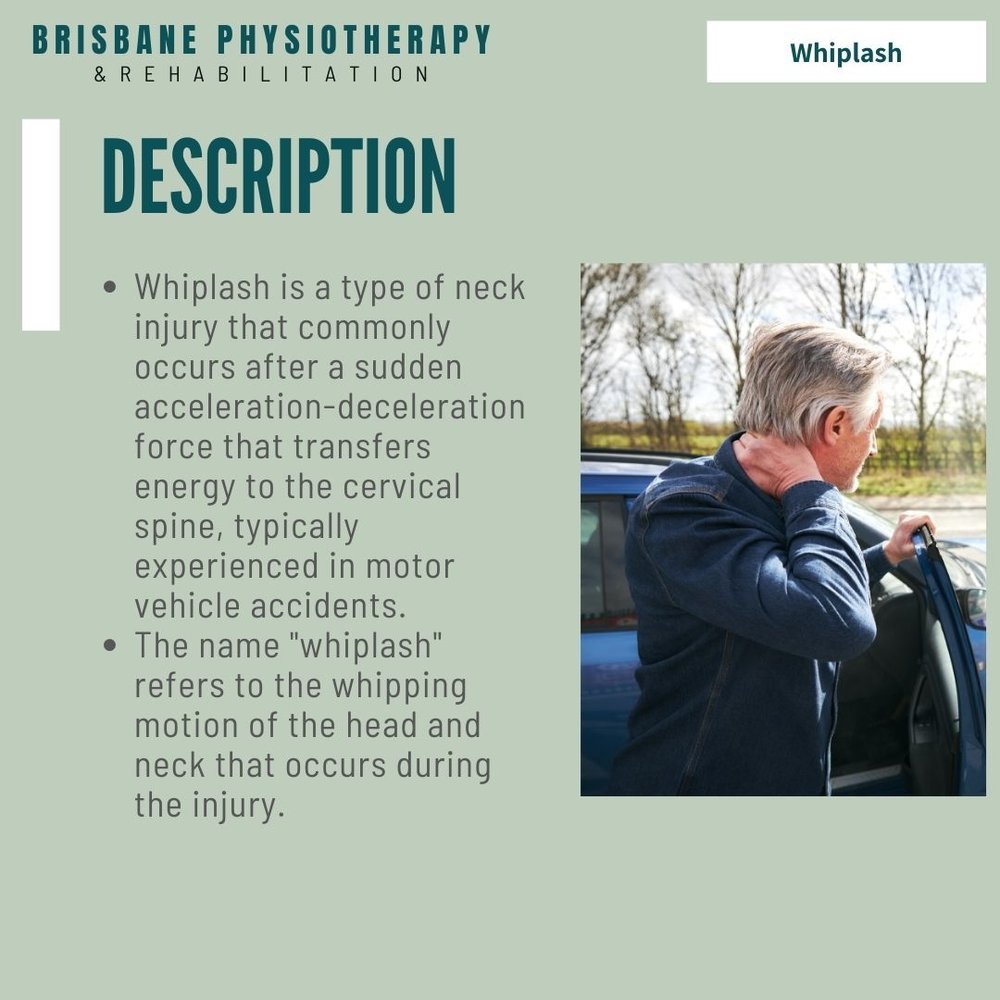
Our Services
Compulsory Third Party (CTP)
Brisbane Physiotherapy is a Motor Accident Insurance Commission (MAIC) service provider.
Some people recover from their injuries and get back to normal activities without treatment or rehabilitation, while others need rehabilitation such as physiotherapy to assist their recovery.
Rehabilitation aims to return you to how you were before the accident.
It is widely recognised that if rehabilitation is needed, it should be provided as soon as possible after the injury. Ask your Doctor / medical practitioner whether they think you need rehabilitation services.
What does the CTP insurer fund?
If the insurer has accepted liability for your claim or agreed to fund rehabilitation without admitting liability, the insurer will pay rehabilitation expenses provided they:
are reasonable and appropriate;
relate to the injuries from the accident; and
are validated e.g. by providing receipts to the insurer.
How Rehabilitation Treatment is Arranged
To get rehabilitation or treatment for your injury, you can contact the CTP insurer or they will contact you.
1. The insurer contacts you
The information in your medical certificate and claim form may enable the insurer to understand if rehabilitation is needed. In this scenario, the CTP insurer may contact you to discuss your rehabilitation.
2. You contact the insurer
You can contact the insurer if you or your medical or rehabilitation provider thinks you need rehabilitation. Either:
or contact the CTP insurer to request funding for your rehabilitation.
You can make this request yourself or through your legal representative (if you have one).
Payment of Rehabilitation or Treatment Expenses
It is best to get approval from the CTP insurer for paying rehabilitation services, before you attend them, to ensure the services will be paid for. Your rehabilitation provider can then send the account directly to the insurer for payment for the treatment that was approved.
If you have paid for rehabilitation and would like to be reimbursed, please provide the insurer with a valid receipt. You can do this online through our Queensland CTP claim portal or by contacting the CTP insurer.
The insurer will then assess whether the services were reasonable and appropriate. Please note that there is no guarantee that an insurer will continue to pay the ongoing cost of a service if they have not approved it before the service is provided. That’s why it is best to seek approval before your appointment, if possible.
Queensland Compulsory Third Party Scheme
Under the Queensland Compulsory Third Party (CTP) Insurance Scheme, you may be entitled to funding of your rehabilitation and medical treatment expenses if you did not cause the motor vehicle accident and the accident occurred in Queensland.
Queensland operates a common law ‘fault’ based CTP scheme. To access the scheme you must be able to establish negligence against an owner or driver of a motor vehicle. A driver who is wholly at fault in an accident cannot obtain CTP compensation because there is no negligent party against whom a claim can be made.
To apply for funding for rehabilitation and treatment, you first need to lodge a Notice of Accident Claim Form with the CTP insurer of the vehicle at fault (vehicle that caused the accident).
For more information about the Queensland CTP scheme and how to make a claim, including the timeframes involved, visit the Motor Accident Insurance Commission (MAIC) website at www.maic.qld.gov.au or call the MAIC helpline.
If you are a National Injury Insurance Scheme Queensland (NIISQ) participant and have a CTP Claim, your treatment, care and support will be provided by NIISQ. Visit www.niis.qld. gov.au or call the NIISQ helpline for more information.
Whiplash is a type of neck injury that commonly occurs after a sudden acceleration-deceleration force that transfers energy to the cervical spine, typically experienced in motor vehicle accidents. The name "whiplash" refers to the whipping motion of the head and neck that occurs during the injury.
Mechanism of injury:
Initially believed to comprise neck hyperextension.
Now acknowledged as a complex buckling of the cervical spine with concomitant tension, shear, flexion and extension at different levels.
‘S’ Shaped curve – lower segments extend as upper segments flex in an abnormal non-physiological movement.
When someone sustains a whiplash injury, they may present with several signs and symptoms, which can vary in severity. Common symptoms include:
Neck pain and stiffness: This is the most prevalent symptom
Restricted range of neck movement.
Headaches: Tension-type headaches or cervicogenic headaches (originating from the neck) are common after whiplash.
Shoulder and upper back pain: The impact of the injury can cause pain and discomfort in the shoulders and upper back.
Arm pain: Some individuals may experience pain that radiates into the arms or upper back due to nerve irritation.
Upper limb neurological compromise: pins/needles and numbness in the arms.
Dizziness and vertigo: Whiplash can affect the vestibular system, leading to feelings of dizziness or a spinning sensation.
Visual and auditory disturbance
Fatigue: Many people with whiplash report fatigue and difficulty concentrating.
Cognitive and psychological symptoms: In some cases, individuals may experience memory problems, irritability, depression, or anxiety.
Physiotherapists play a crucial role in the treatment of whiplash injuries. Their primary goal is to alleviate pain, promote healing, restore function, and prevent long-term complications. Here are some common physiotherapy treatments for whiplash:
Muscle facilitation and re-education:
Motor control retraining: deep neck flexor muscles
Postural re-education: Physiotherapists educate patients about maintaining proper posture and ergonomics to reduce strain on the neck.
Kinaesthetic re-education
Range of motion exercises: Gentle exercises and stretches are prescribed to improve neck mobility and reduce stiffness. Muslces that may be targeted include scalenes, upper traps, levator scap and pectoral
Manual therapy to help alleviate pain and restore joint function:
Massage
Pain-free joint mobilization
Strengthening exercises: Specific exercises are prescribed to strengthen the neck and shoulder muscles, improving stability and preventing further injury. Muscles that may be targeted include rhomboids, rotator cuff, deep neck flexors and serratus anterior.
Education and advice: Patients are provided with information about self-management strategies, including activity modification and home exercises.
Rehabilitation programs: In severe cases or when symptoms persist, physiotherapists may develop comprehensive rehabilitation programs tailored to the individual's needs, incorporating various treatment modalities.
Prognosis: Most recovery occurs in first 2-3 months – little significant change happens after this point.
CTP Insurers
Current CTP insurers
AAI Limited (trading as Suncorp)
Telephone: 13 11 60
Email: qldctpclaims@suncorp.com.au
Website: Visit Website
Allianz Australia Insurance Limited
Telephone:
CTP Product & Quotes enquiries: 131 000
CTP Injury Claims enquiries: (07) 3023 9014Website: Visit Website
QBE Insurance (Australia) Limited
Telephone:
QBE Insurance (Australia) Limited Brisbane: (07) 3859 5666
CTP Injury Claims enquiries: (07) 3031 8418Email: myctpclaim@qbe.com
Website: Visit Website
Previously licensed insurers
RACQ Insurance Limited (trading as RACQ Insurance)
RACQ stopped providing new CTP insurance policies from 1 October 2023. If your current CTP insurer is RACQ, you will remain insured with them until your vehicle registration and CTP insurance policy expire. To learn more, view MAIC’s Frequently-asked questions.
Telephone:
CTP Claims Enquiries: 1800 680 076
CTP Policy Enquiries: 13 19 05Email: ctpclaims@racq.com.au
Website: Visit Website
Insurance Australia Limited (trading as NRMA Insurance)
On 1 January 2014, NRMA ceased to operate as a licensed CTP insurer in Queensland. However, NRMA will continue to be responsible for the management of all existing Queensland CTP claims and new claims from policies sold before 1 January 2014. NRMA’s contact details are:
Telephone: 1800 032 220
Email: qldctp@iag.com.au
Website: Visit Website
Nominal Defendant
The Nominal Defendant is a statutory body established under the Motor Accident Insurance Act 1994 (MAI Act) for the purpose of compensating people who are injured as a result of the negligent driving of unidentified and/or uninsured (no Compulsory Third Party (CTP) insurance) motor vehicles. The Nominal Defendant Fund was first introduced in 1961.
The Nominal Defendant operation is funded by a levy within the CTP insurance premium. The levy is set on the basis of an actuarial assessment of claim trends.
With regard to claims involving uninsured motor vehicles, the Nominal Defendant has the right to recover as a debt, the amount paid in settlement of the claim from the owner or driver (or both) of the uninsured motor vehicle.
The Nominal Defendant is to be taken as a licensed insurer. Under the MAI Act, the Nominal Defendant has the extended role of meeting the claim costs of any licensed insurer who may become insolvent.
Find out more about our treatment modalities:
Book an appointment at our West End or Albion clinics here:



